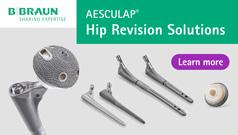
Scientific Debate
Approach to Total Hip Replacement: Have We Reached a Consensus Yet?
  Prepared by Mohamed Sukeik & Fatih Kucukdurmaz SICOT Newsletter Associate Editor - London, United Kingdom & SICOT Young Surgeons Committee Chairman - Istanbul, Turkey |
Total hip replacements (THRs) are among the commonest orthopaedic operations performed and the numbers are increasing due to an aging population [1]. According to the National Joint Registry (NJR) in the United Kingdom, more than 85,000 THRs were performed in 2014 [1]. Despite the overall high rates of satisfaction, a number of controversies remain surrounding the best surgical approach to be utilised for optimal outcomes [2]. The ideal surgical approach should provide excellent exposure to the acetabulum and femur with minimum violation of the surrounding soft tissues in order to reduce operative time, blood loss and post-operative pain, and enhance recovery. It should also be associated with low risk of complications such as periprosthetic fractures, neurovascular injuries, dislocations, infections, thromboembolism and revisions.
A number of surgical approaches for hip replacements have been described as the most common, including the posterior, direct lateral, anterolateral, transtrochanteric lateral and anterior approaches. We will briefly present the advantages and disadvantages of each approach and ask the question whether any of these approaches has gained popularity to become the ideal approach.
Posterior approach (Moore, Southern)
This is the most commonly used approach for THRs accounting for around 60% of cases in the NJR [1]. It was popularised by Moore and is often called the Southern approach [3]. It utilises no internervous planes. Structures at risk include the sciatic nerve and inferior gluteal artery.
Advantages:
Technically simple.
Does not violate the abductor mechanism.
Excellent exposure to both the acetabulum and femur.
Low rates of heterotopic ossification [4].
Disadvantages:
High dislocation rates reported as high as 9.5% in earlier studies [5, 6].
Potential for sciatic nerve injury.
Direct lateral approach (Hardinge)
Popularised by Hardinge [7], the direct lateral approach is the second most commonly used approach for THRs accounting for around 30% of cases in the NJR [1]. It also utilises no internervous planes as it relies on splitting the fibers of the gluteus medius, gluteus minimus and vastus lateralis [7]. Structures at risk include the superior gluteal nerve, femoral nerve, femoral artery and vein, and the transverse branch of the lateral circumflex artery of the thigh.
Advantages:
Better exposure to the femur for reaming than the anterolateral and anterior approaches.
Avoids the need for a trochanteric osteotomy whilst providing good exposure to the joint.
Minimal risk of sciatic nerve injury.
Low dislocation rates.
Disadvantages:
Violates the abductor mechanism which may result in abductors weakness and a Trendelenburg gait due to the detachment of the abductors or injury to the superior gluteal nerve.
Higher rates of heterotopic ossification than the posterior approach [4].
Anterolateral approach (Watson Jones)
This approach also utilises no internervous planes as it uses the intermuscular plane between the tensor fascia latae and gluteus medius both innervated by the superior gluteal nerve [8]. Structures at risk include the femoral nerve, femoral artery and vein, and profunda femoris artery.
Advantages:
Avoids the need for a trochanteric osteotomy if a partial detachment of the abductor mechanism is utilised to expose the joint.
Stability with less chance of posterior dislocation.
Disadvantages:
Exposure to the femur not as good as the posterior and direct lateral approaches which may result in damaging the femoral shaft and malpositioning of the femoral component. Additionally, in difficult exposures, further capsular release and release of the tensor fascia latae and sartorius may be necessary, increasing the risk of soft tissue injury and fractures. A trochanteric osteotomy in some cases may also be necessary.
Abductors weakness during dissection or injury to the superior gluteal nerve [9].
Transtrochanteric lateral approach (Charnley)
Charnley popularised this approach in 1962 with some centres still using it regularly especially for revision THR surgery [10, 11].
Advantages:
Good exposure to both the acetabulum and femur.
Disadvantages:
Non-union of the trochanteric osteotomy, pain, bursitis and wire breakage.
Prolonged operation due to the osteotomy and delayed rehabilitation due to delayed weight-bearing.
Reduced abductor power has been reported with trochanteric migration [12].
Anterior approach (Smith Peterson)
This approach utilises the internervous planes between sartorius (femoral nerve) and tensor fascia latae (superior gluteal nerve) superficially and rectus femoris (femoral nerve) and gluteus medius (superior gluteal nerve) deeply [13]. Structures at risk include the lateral femoral cutaneous nerve, femoral nerve and ascending branch of the lateral femoral circumflex artery.
Advantages:
The only approach which utilises an internervous plane.
Avoids the need for a trochanteric osteotomy in most cases whilst providing good exposure to the acetabulum.
Limited morbidity, early mobilisation and high stability with reduced dislocation rates [14].
Ability to use intraoperative radiographs as the patient is supine.
Disadvantages:
Exposure to the femur is not as good as the posterior and direct lateral approaches. Therefore, in difficult exposures, similar to the anterolateral approach, further capsular release and release of the tensor fascia lata and sartorius may be necessary increasing the risk of soft tissue injury and fractures. A trochanteric osteotomy in some cases may also be necessary. A specialised table is used by some surgeons to facilitate femoral exposure.
The development of a number of approaches over time for THR surgery suggests that no single approach fits the description of the ‘ideal approach’. This is evidenced by the advantages and disadvantages listed above for each approach. In fact, the debate to which approach is better remains a hot topic for almost every conference we attend whereby surgeons with relevant experience of one approach try to present it as the ideal approach.
It is important to note that minimising complications is a key and this is only achieved with appropriate training and mastering of a particular approach to reproduce good results. Modifications to some approaches have also improved complication rates. For example, introduction of the posterior soft tissue repair for the posterior approach improved dislocation rates with no cases of dislocations reported by Pellicci et al [15] in 395 THRs. Similarly, Weeden et al [16] reported 8 cases (0.85%) of dislocations only among 945 primary THRs at a mean of 6.4 years follow-up when the posterior capsule and the short external rotators were repaired to the greater trochanter using a nonabsorbable suture. On the other hand, meticulous handling of the soft tissues and repair of the abductors are essential in the direct lateral approach and when performed satisfactorily, this could yield similar results to the posterior approach for abductor strength and heterotopic ossification [17]. A criticism of the anterior approach is the high complication rates associated with the learning curve [18]. However, recent reports by experts who performed 2,869 cases using this approach reported as low as 0.9% rate of periprosthetic fractures and overall 1.7% complication rates which is equivalent to other approaches [19, 20].
A recent meta-analysis comparing the anterior approach and lateral approaches showed that the anterior approach provides shorter hospitalisation and faster recovery during the early postoperative period. However, authors concluded that the available evidence is still insufficient to confirm whether the anterior or lateral approach is superior for THRs [21]. Another meta-analysis comparing the posterior and lateral approaches showed that the posterior approach conferred a significant reduction in the risk of Trendelenburg gait (odds ratio [OR]: 0.31, p=0.0002) and stem malposition (OR: 0.24, p=0.02), and a non-significant reduction in dislocation (OR: 0.37, p=0.16) and heterotopic ossification (OR: 0.41, p=0.13). However, neither approach conferred a functional advantage. Again the authors drew attention to the paucity of evidence and the need for further randomised trials [22]. A meta-analysis by Jolles et al [23] also suggested that the evidence for superiority of one approach over another in THR surgery is lacking.
In conclusion, the debate on what approach for THR is ideal continues and we certainly need well designed and sufficiently powered randomised controlled studies to answer this question. Until then, the safer option would be to learn the approach of preference at a center with high volume of THRs and low complication rates in order to master the approach and reproduce similar results.
References:
- NJR. http://www.njrcentre.org.uk/njrcentre/Portals/0/Documents/England/Reports/12th%20annual%20report/NJR%20Online%20Annual%20Report%202015.pdf. 2015.
- Glinkowski W, Ciszek B. Anatomical determinations of surgical approaches to the hip joint and their modifications for revision hip arthroplasty. Ortop Traumatol Rehabil. 2001 Jan-Mar;3(1):103-13.
- Lunceford EM, Jr. Use of the Moore Self-Locking Vitallium Prosthesis in Acute Fractures of the Femoral Neck. J Bone Joint Surg Am. 1965 Jun;47:832-41.
- Bischoff R, Dunlap J, Carpenter L, DeMouy E, Barrack R. Heterotopic ossification following uncemented total hip arthroplasty. Effect of the operative approach. J Arthroplasty. 1994 Dec;9(6):641-4.
- Vicar AJ, Coleman CR. A comparison of the anterolateral, transtrochanteric, and posterior surgical approaches in primary total hip arthroplasty. Clin Orthop Relat Res. 1984 Sep(188):152-9.
- Robinson RP, Robinson HJ, Jr., Salvati EA. Comparison of the transtrochanteric and posterior approaches for total hip replacement. Clin Orthop Relat Res. 1980 Mar-Apr(147):143-7.
- Hardinge K. The direct lateral approach to the hip. J Bone Joint Surg Br. 1982;64(1):17-9.
- Watson-Jones R. The classic: "Fractures and Joint Injuries" by Sir Reginald Watson-Jones, taken from "Fractures and Joint Injuries," by R. Watson-Jones, Vol. II, 4th ed., Baltimore, Williams and Wilkins Company, 1955. Clin Orthop Relat Res. 1974 Nov-Dec(105):4-10.
- Pawlowski Z, Bohatyrewicz A, Czajkowski AA, Kominiak P, Gusta A. [Early abductor muscle strength after total hip replacement performed by antero-lateral approach]. Chir Narzadow Ruchu Ortop Pol. 2002;67(4):375-80.
- Charnley J. Total hip replacement by low-friction arthroplasty. Clin Orthop Relat Res. 1970 Sep-Oct;72:7-21.
- Kerboull M, Hamadouche M, Kerboull L. Total hip arthroplasty for Crowe type IV developmental hip dysplasia: a long-term follow-up study. J Arthroplasty. 2001 Dec;16(8 Suppl 1):170-6.
- Menon PC, Griffiths WE, Hook WE, Higgins B. Trochanteric osteotomy in total hip arthroplasty: comparison of 2 techniques. J Arthroplasty. 1998 Jan;13(1):92-6.
- Smith-Petersen MN. Approach to and exposure of the hip joint for mold arthroplasty. J Bone Joint Surg Am. 1949 Jan;31A(1):40-6.
- Light TR, Keggi KJ. Anterior approach to hip arthroplasty. Clin Orthop Relat Res. 1980 Oct(152):255-60.
- Pellicci PM, Bostrom M, Poss R. Posterior approach to total hip replacement using enhanced posterior soft tissue repair. Clin Orthop Relat Res. 1998 Oct(355):224-8.
- Weeden SH, Paprosky WG, Bowling JW. The early dislocation rate in primary total hip arthroplasty following the posterior approach with posterior soft-tissue repair. J Arthroplasty. 2003 Sep;18(6):709-13.
- Barber TC, Roger DJ, Goodman SB, Schurman DJ. Early outcome of total hip arthroplasty using the direct lateral vs the posterior surgical approach. Orthopedics. 1996 Oct;19(10):873-5.
- Muller DA, Zingg PO, Dora C. Anterior minimally invasive approach for total hip replacement: five-year survivorship and learning curve. Hip Int. 2014 May-Jun;24(3):277-83.
- Berend KR, Mirza AJ, Morris MJ, Lombardi AV, Jr. Risk of Periprosthetic Fractures With Direct Anterior Primary Total Hip Arthroplasty. J Arthroplasty. 2016 Mar 15.
- Mirza AJ, Lombardi AV, Jr., Morris MJ, Berend KR. A mini-anterior approach to the hip for total joint replacement: optimising results: improving hip joint replacement outcomes. Bone Joint J. 2014 Nov;96-B(11 Supple A):32-5.
- Yue C, Kang P, Pei F. Comparison of Direct Anterior and Lateral Approaches in Total Hip Arthroplasty: A Systematic Review and Meta-Analysis (PRISMA). Medicine (Baltimore). 2015 Dec;94(50):e2126.
- Berstock JR, Blom AW, Beswick AD. A systematic review and meta-analysis of complications following the posterior and lateral surgical approaches to total hip arthroplasty. Ann R Coll Surg Engl. 2015 Jan;97(1):11-6.
- Jolles BM, Bogoch ER. Surgical approach for total hip arthroplasty: direct lateral or posterior? J Rheumatol. 2004 Sep;31(9):1790-6.

















